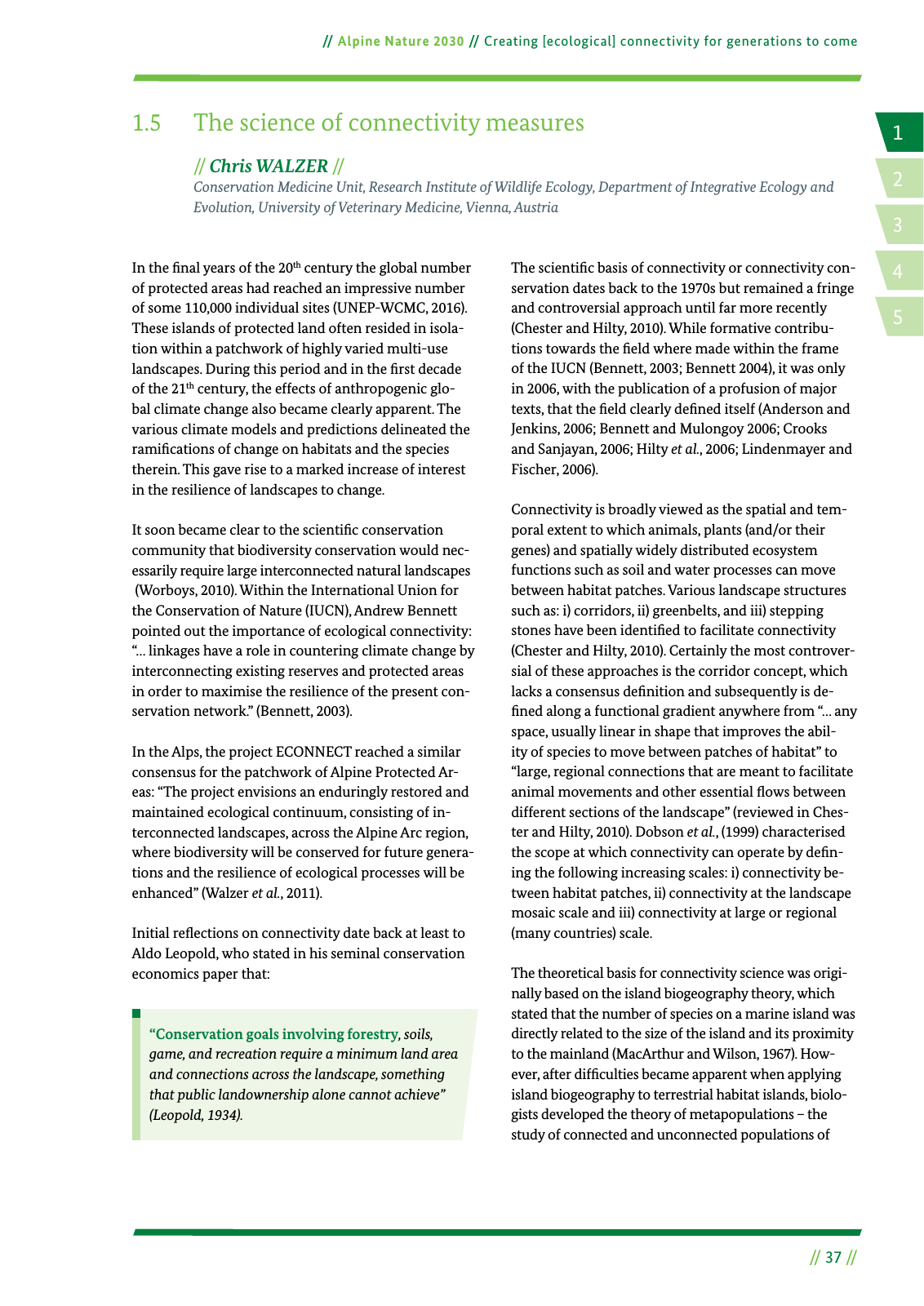14 2 5 3 37 Alpine Nature 2030 Creating ecological connectivity for generations to come 1 5 The science of connectivity measures Chris WALZER Conservation Medicine Unit Research Institute of Wildlife Ecology Department of Integrative Ecology and Evolution University of Veterinary Medicine Vienna Austria In the nal years of the 20th century the global number of protected areas had reached an impressive number of some 110 000 individual sites UNEP WCMC 2016 These islands of protected land often resided in isola tion within a patchwork of highly varied multi use landscapes During this period and in the rst decade of the 21th century the effects of anthropogenic glo bal climate change also became clearly apparent The various climate models and predictions delineated the rami cations of change on habitats and the species therein This gave rise to a marked increase of interest in the resilience of landscapes to change It soon became clear to the scienti c conservation community that biodiversity conservation would nec essarily require large interconnected natural landscapes Worboys 2010 Within the International Union for the Conservation of Nature IUCN Andrew Bennett pointed out the importance of ecological connectivity linkages have a role in countering climate change by interconnecting existing reserves and protected areas in order to maximise the resilience of the present con servation network Bennett 2003 In the Alps the project ECONNECT reached a similar consensus for the patchwork of Alpine Protected Ar eas The project envisions an enduringly restored and maintained ecological continuum consisting of in terconnected landscapes across the Alpine Arc region where biodiversity will be conserved for future genera tions and the resilience of ecological processes will be enhanced Walzer et al 2011 Initial re ections on connectivity date back at least to Aldo Leopold who stated in his seminal conservation economics paper that Conservation goals involving forestry soils game and recreation require a minimum land area and connections across the landscape something that public landownership alone cannot achieve Leopold 1934 The scienti c basis of connectivity or connectivity con servation dates back to the 1970s but remained a fringe and controversial approach until far more recently Chester and Hilty 2010 While formative contribu tions towards the eld where made within the frame of the IUCN Bennett 2003 Bennett 2004 it was only in 2006 with the publication of a profusion of major texts that the eld clearly de ned itself Anderson and Jenkins 2006 Bennett and Mulongoy 2006 Crooks and Sanjayan 2006 Hilty et al 2006 Lindenmayer and Fischer 2006 Connectivity is broadly viewed as the spatial and tem poral extent to which animals plants and or their genes and spatially widely distributed ecosystem functions such as soil and water processes can move between habitat patches Various landscape structures such as i corridors ii greenbelts and iii stepping stones have been identi ed to facilitate connectivity Chester and Hilty 2010 Certainly the most controver sial of these approaches is the corridor concept which lacks a consensus de nition and subsequently is de ned along a functional gradient anywhere from any space usually linear in shape that improves the abil ity of species to move between patches of habitat to large regional connections that are meant to facilitate animal movements and other essential ows between different sections of the landscape reviewed in Ches ter and Hilty 2010 Dobson et al 1999 characterised the scope at which connectivity can operate by de n ing the following increasing scales i connectivity be tween habitat patches ii connectivity at the landscape mosaic scale and iii connectivity at large or regional many countries scale The theoretical basis for connectivity science was origi nally based on the island biogeography theory which stated that the number of species on a marine island was directly related to the size of the island and its proximity to the mainland MacArthur and Wilson 1967 How ever after dif culties became apparent when applying island biogeography to terrestrial habitat islands biolo gists developed the theory of metapopulations the study of connected and unconnected populations of

Hinweis: Dies ist eine maschinenlesbare No-Flash Ansicht.
Klicken Sie hier um zur Online-Version zu gelangen.
Klicken Sie hier um zur Online-Version zu gelangen.